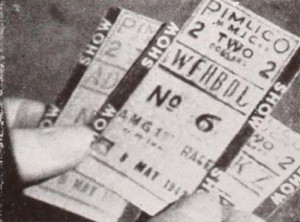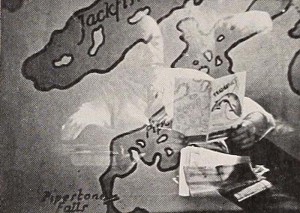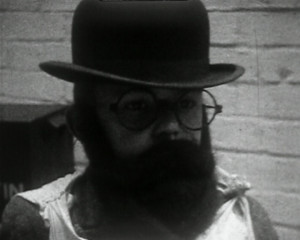
‘Camera pans over cottages in the village of Tolleshunt D’Arcy. Paintings of the coronation are shown followed by a photo of Queen Elizabeth II. A shot of the church with two old men sitting on a bench by the road. Another shot of the church followed by a sign post for the village and the Union Jack flag flying. A man goes into a telephone box in the middle of the village as a bus drives past. Flags and bunting decorate the village. Two women come out of a shop. One woman gets onto a bike and the other walks away. There is a shot of Tolleshunt D’Arcy Post Office and the postmistress, Miss Blaxhall, comes out under the filmmaker Joyce Allingham's direction. The baker puts up coronation decorations outside his shop and people put decorations on string around the village. A little girl waves a Union Jack flag. Close up of a girl and boy decorating pots using red, white and blue ribbon. Shots of people decorating their gardens. Two people come out of a Co-operative store and a little girl walks down the street carrying a basket. Mr and Mrs Emeny come out of the Thatcher’s Arms and another couple walk out of the front door of their cottage and smile at the camera. A woman wraps red, white and blue ribbon around her bird table and another woman carries a crown on a pillow. Camera pans across the street to show the villagers decorating. Children play in the street and a father lifts his little girl up to the camera and they both wave. People stand in a group and look at the camera. Miss Jessie Bacon looks through the window of Salter Lodge. Shot of the decorated D’Arcy Motors garage. The owner stands outside the garage where the Castrol oil and Esso petrol is sold. The proprietor, his wife and dog stand outside the Red Lion pub. Joyce’s sister, Margaret Allingham, and Margaret's husband, Philip Youngman Carter, stand outside their home in the main street. They then pose by the front door of D’Arcy House. Shot of a dog sitting in the garden. Close up of a woman hanging her washing on the line. Various shots of villagers going to church. A woman and her two children stand outside their home looking at the camera. A man climbs up a ladder to put up some bunting. Various villagers pose for the camera outside their homes and shops. One man cuts a rose and smells it. A car drives along the road followed by a shot of people coming out of a village shop. Shot of people looking out of the windows of the Queens Head pub and standing outside the tobacconist shop. Various shots of villagers standing outside shops and houses. A poster introducing the Tolleshunt D’Arcy Coronation Celebrations, June 2nd 1953 at the grounds of D’Arcy House. The poster states that there is a television in the village by Radio Vision, Maldon. It gives the line up of events for the day: Parade meet at The Maypole at 1.40pm followed by 3.45pm Sports; 4:30pm Sit Down Tea For Children; 5.00pm Running Buffet For Everyone; 5.40pm Sports Continued; 7.15pm Presentation of Prizes; 8.30pm Dancing in The Village. The procession of decorated lorries, vans, prams, cycles and fancy dress is shown. Camera pans over the people in the crowd dressed up in costumes. Close ups of the carnival floats driving past the camera. Children participate in various relay races. The film ends with scenes of a pram race with men dressed as women and the adult 'babies' drinking pints of beer’ (EAFA).

"In Turf Tales, Leonard Bauer, jr., has tackled an acceptedly difficult subject for the personal movie maker — and has done well by it. The subject, as might be guessed, is professional horse racing. The setting of Mr. Bauer's study is the relatively ancient track of Pimlico, outside Baltimore, with the climax of the picture provided by a record of its traditional classic, the Preakness. But the strength of Turf Tales derives more from its highly competent sequences of human interest behind the scenes — the early morning time trials, the stable boys and their chores, the track farrier as he shapes the delicate racing shoes and the strange, unexplained mascots of the high strung thoroughbreds. A commendably restrained narrative, set against a musical background, accompanies the film on a sixteen inch disc recorded by Mr. Bauer." Movie Makers, Dec. 1944, 496-497.
"Two Minutes to Play, running two reels, 16mm., and a production of the Greenbrier Amateur Movie Club under the direction of Hal Morey, ACL, stands out among the year's films because of its unusually deft cutting and shrewd camera treatment. Although plotted on the standard football yarn, the picture tells its story swiftly, smoothly and with a rising tempo of excitement that is a direct tribute to the production and to the editing. Consistently good photography, effective and varied camera angles and a well planned script were contributing factors in the success of this genuinely entertaining film story." Movie Makers, Dec. 1932, 538.

"No better example of human interest in a vacation film will be seen for a long time to come than was exhibited in Two Perfect Weeks, made by Walter F. Hinkle. Strangely enough, there was practically no material of actually catching fish, yet the film gives one the impression that the party consisted of all genuine fishermen and that no more dyed in the wool sportsmen could be found than these happy vacationists. Starting with a clever introduction, the film moves rapidly along into camp. Here, a most handsome array of interest packed close shots serves to tell the story of tired business men at play, until the entire audience is ready to sit down and enjoy a meal of freshly cooked fish. The film ends in a novel way. To signalize the return to civilization, each member of the party is seen shaving off the beard that grew during the two weeks at camp. Although each of the group is introduced by means of a different type of activity, the picturization is at no time slow or dull. The secret lay in the fact that there was no "monkey business" in front of the camera, but rather a good collection of intimate views of the persons going about their various tasks. The color titles are well executed." Movie Makers, Dec. 1939, 632-633.
"In Two Weeks, W. W. Champion has contrived that rare and refreshing thing — a personal record picture implicit with general human interest. Telling the story of a fortnight's pack trip with friends through Yosemite, the film gets off to a flying start with a delightfully detailed sequence of camp preparations. With complete naturalness, we are made acquainted with each of the vacation party. When, in good time, they set off down the trail, we feel quite sure that these people will prove of more interest than the locales that they will visit. Mr. Champion does not disappoint us, as he continues with an adroitly spun pattern of personalities and places. Crisp, steady and effectively angled, the photography of the film, in both monochrome and color, is of able assistance to the imaginative treatment." Movie Makers, Dec. 1936, 542.
"Tying A Dry Salmon Fly, 300 ft., 16mm., was awarded special mention because of its unusual subject matter and because of the uniformly fine technique with which it is portrayed. Mr. Brock, both a fisherman and a firmer, has brought one hobby to the aid of another as he shows, with a straightforward continuity, the nice art of fly tying. Working almost entirely in extreme closeups, he overcame the serious problem of limited depth of focus by a canny concentration of his light sources on the tiny subject. In this manner, he was able so to stop down the lens as to achieve maximum definition and depth of field." Movie Makers, Dec. 1931, 685.
"Under the Maple Leaf, by Hamilton H. Jones, ACL, is a partially refilmed and entirely reedited version of last year's award winner, Canadian Capers. A splendid picture a year ago, its new and additional sequences now bring to the film a photographic beauty plainly of the very first rank. A sequence of the morning mist rising from a lake deserves particular mention. Mr. Jones's considerable skill with his camera has increased in stature and may not yet have reached its full flowering. For this accomplishment his work has been given a place of honor in these selections. In the reluctant estimation of the judges, however, the editing and cutting of Under the Maple Leaf so far lagged behind its generally matchless beauty as to rob the film of its fullest emotional power. This factor only prevented Mr. Jones from repeating this year his full triumph of a year ago." Movie Makers, Dec. 1933, 523-524.

"An amateur comedy drama about a young Englishman pursued by Russian spies and the kidnapping of his girlfriend." (EAFA Database)
"A Vacation with Lucy Carlisle, Margaret Pinkham, Virginia Carlisle." oldfilm.org
Total Pages: 14